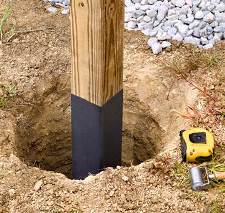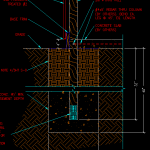Does Concrete in Contact With Treated Pine Cause Premature Wood Decay?
Four decades plus of post-frame (pole) buildings (roughly 20,000 of them) with no premature decay of a single properly pressure preservative treated wood post has led me to be a staunch support of columns embedded in ground.
Actual scientific studies do seem to back up my real life experience (please read https://www.hansenpolebuildings.com/2020/09/pressure-treated-post-frame-building-poles-rot/).
So, when social media posts about different scenarios causing pressure treated wood decay crop up, my favorite response is, “Please share with me any peer reviewed studies to back up your claim”.
Well, I actually got one and learned something new.
Here is this report’s abstract:
“Treated wood timbers employed in ground contact are often installed with a cement collar to firmly fix the structural wood post in place. Few prior studies have determined the effect of concrete on decay efficacy on treated wood, however. Treated wood nominal 4 × 4 posts were installed at four locations, with the upper ground-contact portion of each post encased in concrete, and the samples removed at various times for pH measurements. The wood alkalinity quickly increased at all four sites for the portion of the treated wood in concrete contact compared to the wood in ground contact without concrete. In laboratory decay tests employing three decay fungi, untreated wood which was first exposed or unexposed to concrete had no consistent difference in decay susceptibility. For wood treated with three different commercial copper/organic systems, cement exposure had no effect on wood treated with an amine copper azole system, while treatment with amine copper quat showed a statistically significant fungal efficacy enhancement for cement-exposed samples with both copper-tolerant fungi. Conversely, with a micronized copper azole preservative, cement exposure resulted in reduced fungal efficacy compared to treated samples which were not cement-exposed for all three decay fungi.”
And conclusions:
“Commercial MCA-treated ground-contact posts surrounded by a concrete collar installed at four outdoor sites quickly increased to a greater pH than the lower portion of the post below the concrete at all four test sites locations. In laboratory soil block decay tests, untreated pine sapwood which was exposed or not exposed to concrete prior to fungal testing showed no deterioration effect upon exposure for 4 and 6 weeks to three different fungi. With wood samples treated with three commercial copper organic preservatives and exposed to three decay fungi, different decay efficacies were obtained for samples which were exposed to concrete depending on the particular preservative employed; for all three systems greater deterioration was always observed with the two copper-tolerant fungi than the copper-intolerant fungus. Specifically, the amine copper azole preservative CA-C showed no difference in deterioration with all three fungi. The amine copper quat system ACQ-D showed significantly greater decay resistance for the cement-exposed samples with both exposure times and the two copper-tolerant decay fungi. Conversely, for micronized copper azole MCA-treated wood, the cement-exposed samples had greater deterioration with all three fungi compared to the non-cement-exposed samples, with some of the greater decay statistically significant. We conclude that for wood treated with copper-based preservatives and then exposed to concrete when installed in ground contact, decay susceptibility may be unaffected, reduced, or enhanced, depending on the particular copper/organic wood preservative employed.”
 My recommendation would be this…. A recent study has shown concrete(cement being a component of concrete) in contact with pressure preservative treated pine may encourage premature decay by brown-rot fungi. As such, we strongly recommend isolating such columns from concrete starting at splash plank top, to 14 to 18 inches below grade by use of a moisture impervious barrier. Hansen Pole Buildings offers an optional high quality HDPE plastic “SHORT SLEEVE” to fit most column dimensions. For pressure preservative treated pine splash planks, Plasti-Skirts are an available option (please read more here: https://www.hansenpolebuildings.com/2017/08/plasti-skirt/).
My recommendation would be this…. A recent study has shown concrete(cement being a component of concrete) in contact with pressure preservative treated pine may encourage premature decay by brown-rot fungi. As such, we strongly recommend isolating such columns from concrete starting at splash plank top, to 14 to 18 inches below grade by use of a moisture impervious barrier. Hansen Pole Buildings offers an optional high quality HDPE plastic “SHORT SLEEVE” to fit most column dimensions. For pressure preservative treated pine splash planks, Plasti-Skirts are an available option (please read more here: https://www.hansenpolebuildings.com/2017/08/plasti-skirt/).
Interested in reading entire study article? https://www.mdpi.com/1999-4907/11/1/41
Tag Archives: brown rot fungi
How to Prevent Existing 6×6 to Prevent Future Settling and Rotting
Reader BARRY in FREDERICKTOWN writes:
“I recently acquired some property with an existing pole barn “house” on it. It is an unfinished 20’x30′ room with corrugated steel siding, a trussed, steel covered roof and several doors and windows. It was built with a raised floor attached to the 6×6 treated beams set deep into the rocky soil. Before I make any improvements to the inside of the structure to make it livable I am wondering if there is any process I can do now to set the existing 14 6×6 supports on concrete piers or a footing to prevent future settling and rotting. I cannot see any existing concrete surrounding or supporting the vertical 6×6’s. I would hate to invest anything on the inside of a structure that was not set on a good foundation.”
 Mike the Pole Barn Guru writes:
Mike the Pole Barn Guru writes:
If your existing columns are showing no decay signs then they are probably adequately pressure preservative treated. You could excavate around each column, to below frost line. Hole diameter (to provide sufficient bearing surface) should be determined by an engineer, however for sturdy soils and small spans, usually 24 inch diameters will be sufficient.
Drill each column, in both directions using a 5/8” bit, six to 12 inches above column base. Insert a #4 re-bar dowel (#4 is 1/2″ diameter) through each hole.
Galvanized re-bar is recommended. Otherwise, coat rebar penetrating column with an asphalt emulsion, or similar, to isolate re-bar from pressure treated wood.
Seal rebar, into bored holes, at each column edge with silicone caulking.
Before backfilling holes with premix concrete, make sure floor is level. If not, slowly jack floor up to be level with highest point and temporarily brace.
A recent study has shown concrete in contact with pressure preservative treated pine may encourage premature decay by brown-rot fungi. As such, we strongly recommend isolating such columns from concrete starting at splash plank top (roughly 7-1/4″ above grade), to 14 to 18 inches below grade by use of a moisture impervious barrier. Then backfill holes with pre-mix.
If premature post decay is apparent, here are some other options: https://permacolumn.com/pdfs/perma-column-rotted-posts-repair-guide.pdf






